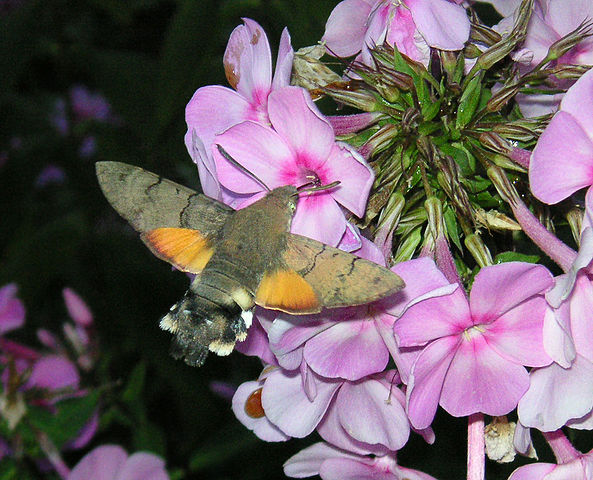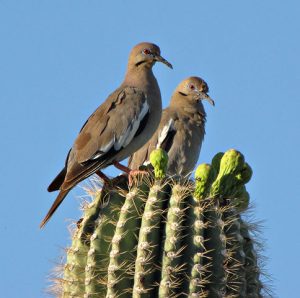The Hummingbird Moth, Great Copycat, Great Pollinator
By Sy Maher
What is that hovering in the garden? Anna’s hummingbird or a Black-chinned hummingbird? No. On closer inspection, I see a Hummingbird moth. Also known as the Hummingbird Sphinx, or hawk-moth. It is one of nature’s best copycats. They can fly side-to-side, and backward, and hover in mid-air just like a hummingbird can. There are 23 believed species of these fluttering pollinators.
Hummingbird hawk-moth in flight

The wing action is frozen in this photo by using electronic flash. This picture was shot in Hanko, Finland, latitude 60°N, on August 19, 2006, thus far north of the typical residential distribution
Hummingbird moths pollinate flowers such as Blue Sage, Carolina Rose, Meadow Rose, Petunias and Evening primroses. They suck the nectar out with a proboscis (feeding tube) that exceeds 10 inches in some species. It rolls up like a party noisemaker when not in use making this creature look just like many other moths while it is resting. They are mostly nocturnal but have been spotted in the day as well, but truly prefer dusk. Almost all of these moths hover and feed like hummingbirds.

Larva of Macroglossum stellatarum (Caterpillar)
The lifecycle of a hummingbird moth can be from egg to adult in less than two months in the summer or it rests in the soil until the weather warms after winter is over. Adults lay their eggs under leaves. The eggs hatch into the larval stage. Big green caterpillars loathed by gardeners, the caterpillar (larvae) of the Hummingbird moth is called a hornworm.
They like to eat tomato plants. While I tried to remove one from a Roma plant, it bobbed its head around as if trying to strike’ It spewed forth a green substance from its mouth. It attacked me! Research confirmed the defensive behavior of the young insect. According to Desert USA, the name “sphinx moth” derives from the behavior of the caterpillar. “When alarmed, these larvae rear up their heads in a threatening sphinx-like posture and may emit a thick, green substance from their mouths.”
Yuk!
Although bees are still the best pollinators, we need to give moths their due.
Photography
Cover and inside photography: Hawk-moth in flight By IronChris – Wikipedia. See other versions, CC BY-SA 3.0, https://commons.wikimedia.org/w/index.php?curid=1008123
The wing action is frozen: By Wikipedia editor J-E Nyström (User: Janke), Finland, CC BY-SA 2.5, Larva of Macroglossum Stellatarum (Caterpillar): By A. M. Liosi – Own work, CC BY-SA 2.5, https://commons.wikimedia.org/w/index.php?curid=1768681
Source
https://www.desertusa.com/insects/sphinx-moths.html
https://owlcation.com/stem/Truly-Ugly-Caterpillar-and-the-Amazing-Moth-It-Becomes
https://www.fs.fed.us/wildflowers/pollinators/pollinator-of-the-month/hummingbird_moth.shtml


